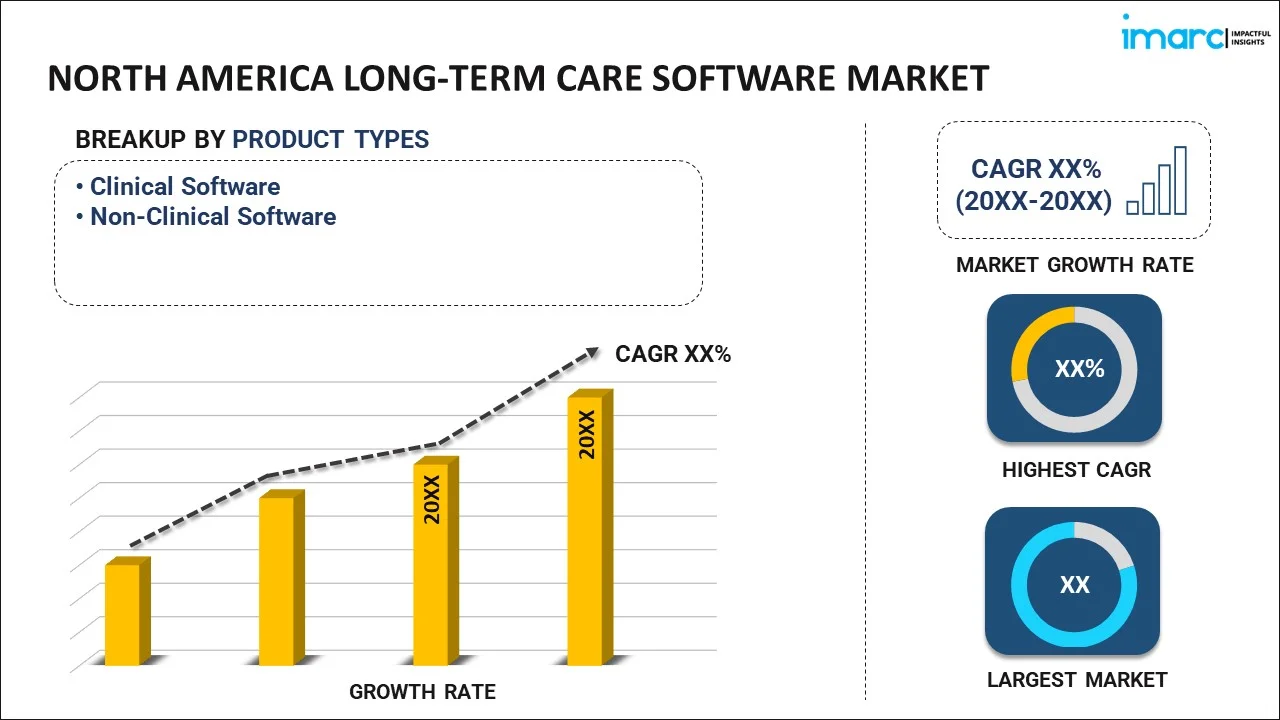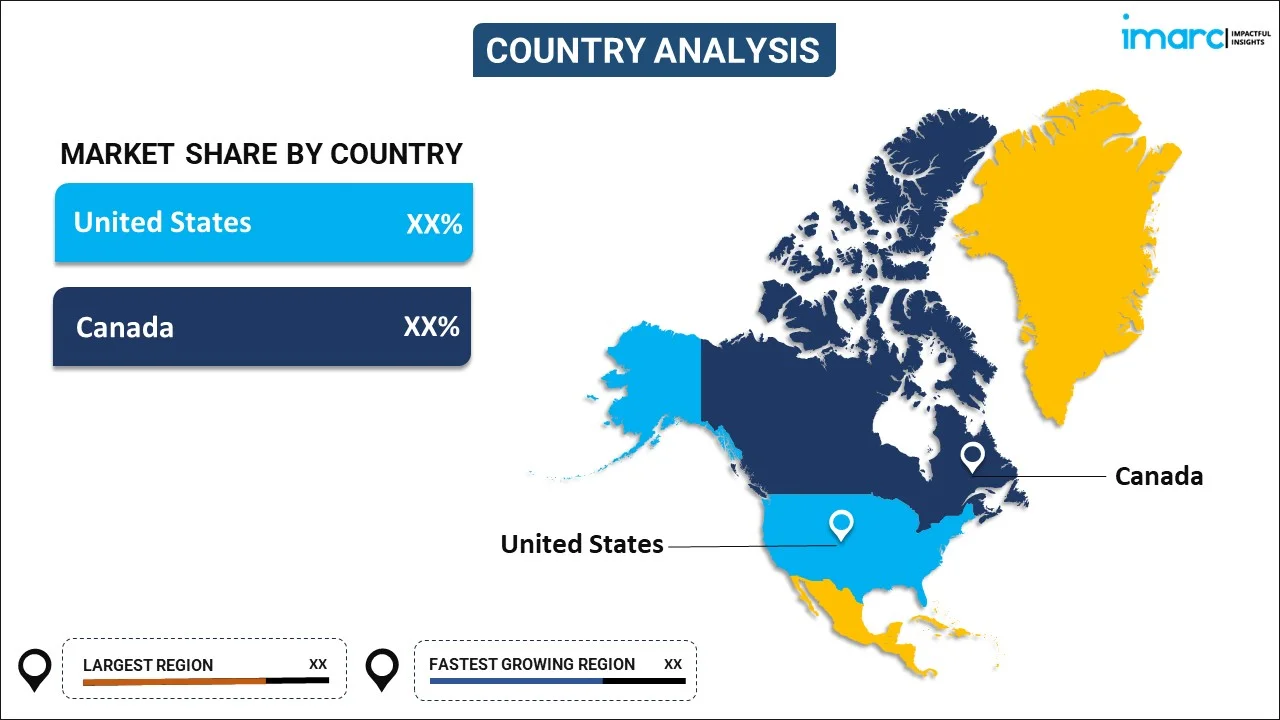
North America Long-Term Care Software Market Report by Product Type (Clinical Software, Non-Clinical Software), Mode of Delivery (Web-Based, On-Premises, Cloud-Based), End User (Nursing Homes and Assisted Living Facilities, Home Healthcare Agencies, Hospice Care Facilities, and Others), and Country 2025-2033
Market Overview:
The North America long-term care software market size reached USD 1.8 Billion in 2024. Looking forward, IMARC Group expects the market to reach USD 4.2 Billion by 2033, exhibiting a growth rate (CAGR) of 9.2% during 2025-2033.
|
Report Attribute
|
Key Statistics
|
|---|---|
|
Base Year
|
2024
|
|
Forecast Years
|
2025-2033
|
|
Historical Years
|
2019-2024
|
|
Market Size in 2024
|
USD 1.8 Billion |
|
Market Forecast in 2033
|
USD 4.2 Billion |
| Market Growth Rate 2025-2033 | 9.2% |
Long-term care software stands for a technological solution designed to provide digital storage and access to a patient's medical information. It is used across facilities that provide long term care services to patients who need medical assistance on a daily basis. Apart from storing health records, long-term care software also helps in providing explicit patient information, maintaining compliance, minimizing data redundancy, financial management, and revenue cycle management. In North America, the software is widely deployed across nursing homes, assisted living facilities, home healthcare agencies, and hospice care facilities.
The increasing geriatric population who are more prone to chronic diseases resulting in mobility impairment and urinary incontinence is propelling the demand for long-term care software in North America. Furthermore, rising digitalization in the healthcare industry coupled with the continuous upgradation of clinical and non-clinical infrastructures is also bolstering the market growth. Besides this, increasing healthcare expenditures, particularly across the US and Canada, for advanced and efficient long-term care services, are further catalyzing the market. The growing awareness towards several benefits associated with long-term care software, such as staff management, compliance and safety, customer relationship management, and point-of-care services, is further propelling the market growth. Additionally, the increasing penetration of cloud-based solutions and remote patient monitoring in the healthcare sector is also augmenting the adoption of long-term care software in North America. Besides this, the wide presence of numerous initiatives by the US government for improving healthcare facilities for the elderly population through Medicare and Medicaid systems is further driving the market. Furthermore, several regional key players are focusing on software upgradation by incorporating AI-based solutions for providing personalized care services. Moreover, the introduction of advanced software solutions with mobile connectivity, centralized database, and user-friendly graphic user interface (GUI) is further expected to drive the market for long-term care software in North America.
Key Market Segmentation:
IMARC Group provides an analysis of the key trends in each segment of the North America long-term care software market report, along with forecasts at the regional and country levels from 2025-2033. Our report has categorized the market based on product type, mode of delivery and end user.
Breakup by Product Type:

- Clinical Software
- Electronic Health Records
- E-Prescribing
- Electronic Medication Administration Records
- Clinical Decision Support Systems
- Medication Management
- Non-Clinical Software
- Real-Time Location Systems
- Remote Patient Monitoring Systems
- Remote Training and Supervision Systems
- Payroll Software
- Billing, Invoicing & Scheduling Software
- Talent Management Software
Breakup by Mode of Delivery:
- Web-Based
- On-Premises
- Cloud-Based
Breakup by End User:
- Nursing Homes and Assisted Living Facilities
- Home Healthcare Agencies
- Hospice Care Facilities
- Others
Breakup by Country:

- United States
- Canada
Competitive Landscape:
The competitive landscape of the industry has also been examined with some of the key players being Allscripts Healthcare Solutions, Inc., Cerner Corporation, Epic Systems Corporation, Kronos Incorporated (Hellman & Friedman), Matrixcare, Inc., McKesson Corporation, Netsmart Technologies, Inc., Omnicare, Inc. (CVS Health Corporation), Omnicell, Inc., Optimus Emr, Inc. (Yardi Systems, Inc.), and PointClickCare Corp.
Report Coverage:
| Report Features | Details |
|---|---|
| Base Year of the Analysis | 2024 |
| Historical Period | 2019-2024 |
| Forecast Period | 2025-2033 |
| Units | Billion USD |
| Segment Coverage | Product Type, Mode of Delivery, End User, Country |
| Countries Covered | United States, Canada |
| Companies Covered | Allscripts Healthcare Solutions, Inc., Cerner Corporation, Epic Systems Corporation, Kronos Incorporated (Hellman & Friedman), Matrixcare, Inc., McKesson Corporation, Netsmart Technologies, Inc., Omnicare, Inc. (CVS Health Corporation), Omnicell, Inc., Optimus Emr, Inc. (Yardi Systems, Inc.), and PointClickCare Corp |
| Customization Scope | 10% Free Customization |
| Post-Sale Analyst Support | 10-12 Weeks |
| Delivery Format | PDF and Excel through Email (We can also provide the editable version of the report in PPT/Word format on special request) |
Key Questions Answered in This Report:
- How has the North America long-term care software market performed so far and how will it perform in the coming years?
- What has been the impact of COVID-19 on the North America long-term care software market?
- What are the key regional markets?
- What is the breakup of the market based on the product type?
- What is the breakup of the market based on the mode of delivery?
- What is the breakup of the market based on the end user?
- What are the various stages in the value chain of the industry?
- What are the key driving factors and challenges in the market?
- What is the structure of the North America long-term care software market and who are the key players?
- What is the degree of competition in the market?
Need more help?
- Speak to our experienced analysts for insights on the current market scenarios.
- Include additional segments and countries to customize the report as per your requirement.
- Gain an unparalleled competitive advantage in your domain by understanding how to utilize the report and positively impacting your operations and revenue.
- For further assistance, please connect with our analysts.
 Inquire Before Buying
Inquire Before Buying
 Speak to an Analyst
Speak to an Analyst
 Request Brochure
Request Brochure
 Request Customization
Request Customization




.webp)




.webp)












